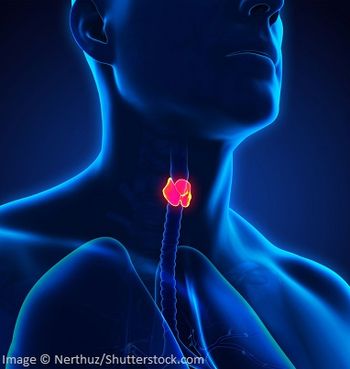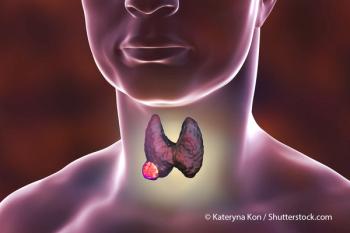
Increased Toxicity Confirmed for Thyroid Cancer Patients on Sorafenib
An increased rate of adverse effects is seen in patients with differentiated thyroid cancer who are being treated with the tyrosine kinase inhibitor sorafenib.
Published literature shows that use of the tyrosine kinase inhibitor sorafenib results in an increase in the rate of adverse effects when used to treat patients with differentiated thyroid cancer, according to the results of a review
Specifically, results from the DECISION trial, which were the basis of the drug’s approval by the US Food and Drug Administration in this patient population, showed that 98% of patients assigned to the drug had an adverse effect, with 1 in 5 reporting a grade 3 or 4 toxicity.
The review discussed many of the possible reasons for this increase in adverse effects, but emphasized that the exact mechanism for this increase is still unclear.
“This differential toxicity may also be relevant for newer agents such as lenvatinib. If it is drug class–specific, the mechanism of increased toxic effects with sorafenib in thyroid cancer patients may also apply in those receiving lenvatinib,” wrote Gary W. Jean, PharmD, of the department of pharmacy practice at Texas Tech University Health Sciences Center School of Pharmacy in Dallas, and colleagues. “Future research should be conducted in an effort to clarify this clinical question and enable practitioners to make appropriate dose adjustments in this population.”
To gather the information, Jean and colleagues searched published literature from the last 15 years that dealt with sorafenib and its common adverse effects. Published data revealed that the most commonly occurring adverse reaction among thyroid cancer patients assigned sorafenib was hand-foot skin reaction (HFSR).
“It typically presents as hyperkeratotic lesions with a peripheral halo of erythema on the palms and soles. In more severe cases, superficial blistering and callus formation can be seen on the flexural surfaces of digits,” the researchers wrote.
A phase II study by Gupta-Abramson et al showed that 93% of patients assigned sorafenib had HFSR; 20% of patients discontinued treatment and 47% required dose reductions. In a second phase II study by Kloos et al, HFSR occurred in 63% of patients, with 52% requiring a dose reduction. Similarly, results from the phase III DECISION trial showed that 76.3% of patients assigned sorafenib experienced HFSR.
“Looking at all the adverse effect rates with sorafenib use in differentiated thyroid cancer reported thus far, it is noteworthy that the incidence rate of adverse effects due to sorafenib appears to be considerably higher in differentiated thyroid cancer patients than in renal cell carcinoma and hepatocellular carcinoma populations, as demonstrated in phase II and III trial data,” the researchers wrote. “The reasons for this phenomenon of increased sorafenib toxic effects in differentiated thyroid cancer patients are not clear.”
Jean and colleagues discussed several of the proposed mechanisms for the increase in HFSR seen in patients with thyroid cancer assigned sorafenib, including direct toxic exposure to the skin from concentrations of the drug in sweat glands and the drug’s inhibition of vascular endothelial growth factor receptor resulting in vascular damage and inflammation in high-pressure areas.
Pharmacokinetic modeling collected from select patients in the DECISION trial showed that their sorafenib exposure was almost twice that as found in other cancer types. Although the researchers noted that the cause of this increase is not known, data did not show that the increased exposure was linked to an increase in toxicity.
“Taking all these facts into consideration, a clear determination of the underlying cause of increased adverse effects in differentiated thyroid cancer patients receiving sorafenib cannot be currently made,” concluded the authors. “Further prospective and retrospective research efforts should focus on identifying potential clinical factors associated with the increased risk of adverse effects, which would ideally lead to an evidence-based, appropriate dosage recommendation to enable differentiated thyroid cancer patients to derive maximum therapeutic benefit from sorafenib while minimizing its adverse effects.”
Newsletter
Stay up to date on recent advances in the multidisciplinary approach to cancer.





